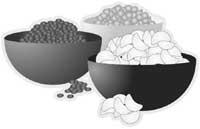Vegetables: high-density foods
2000/05/01 Lorenzo, Arantza | Uranga, Ane Miren Iturria: Elhuyar aldizkaria
As has already been commented, although in each plant we take advantage of a different part, all are very similar in the ingredients. In all of them most (about 90%) is water, and although they have very little energy (20 to 40 kcal per 100 g), the density of mineral salt and vitamin is enormous. Hence, vegetables are considered as regulatory foods and not as plastics or energy.
Its content in carbohydrates is less than 12% and most are in the form of glucose, fructose and sucrose. They highlight the quantity and type of fibres they contain. The fiber of the first plants of the season is usually soft and can be consumed raw. As for the finals, being much harder, to be able to digest them it is necessary to cook them or crush them.
Its fat content is practically null and its protein content is very reduced, being the majority enzymes of special properties. For example, cinarine containing alcochofa, in addition to causing bile secretion, is considered as a remedy for liver, bile, and kidney problems. To maintain in good condition these mineral salts and vitamins it is necessary to follow a series of tips. Buy vegetables and consume as quickly as possible. In steam there are hardly any losses, but if we cook them, we will use little water and pour water into the pot when it is boiling. The less time is under pressure (2-3 minutes vegetables that are foil and 5-8 minutes the rest), the less losses will be. The ideal means for maintaining vitamins is acid. That is why we must take into account this habit of adding bicarbonate to live the color of the vegetables, since the medium that generates is basic, harmful to vitamins. Finally, we eat the salad as soon as we prepare it and if you will spend time at the table, add the vinegar or a few drops of lemon to keep the vitamins.
Finally, we must take into account that to meet our needs of vitamins, mineral salts and fibers, it is essential in one way or another (but always following the advice of conservation of vitamins) to introduce the vegetables in our diet daily.

Gai honi buruzko eduki gehiago
Elhuyarrek garatutako teknologia





